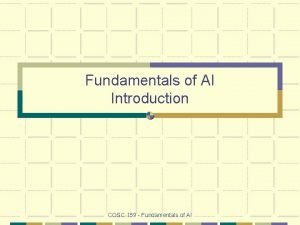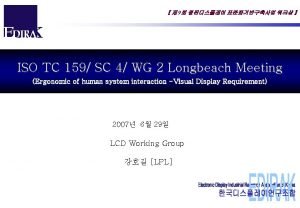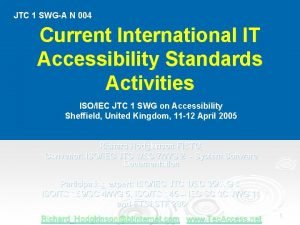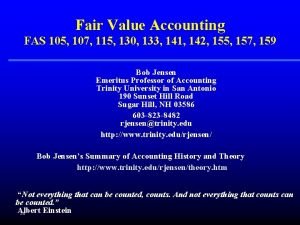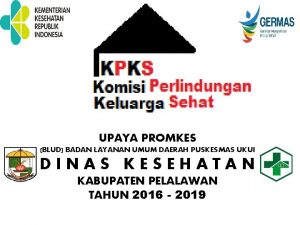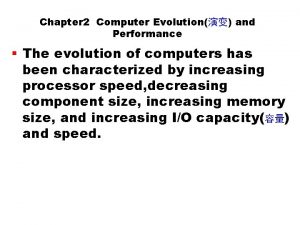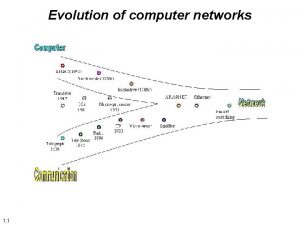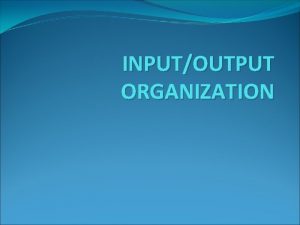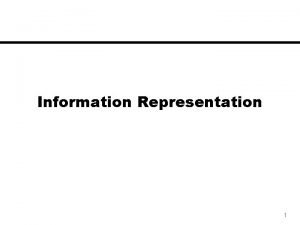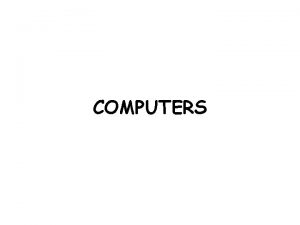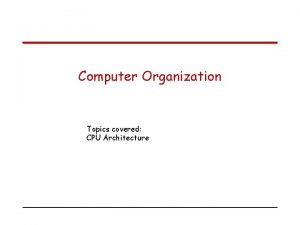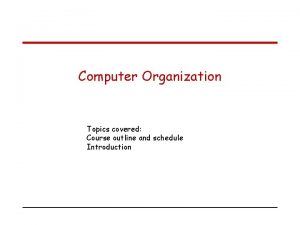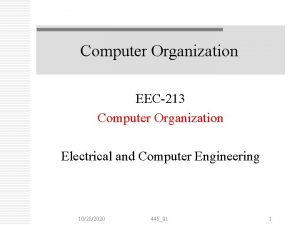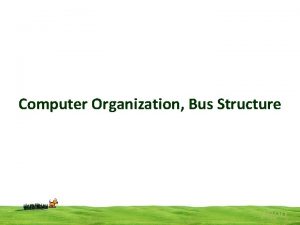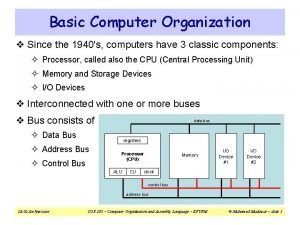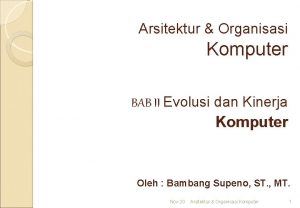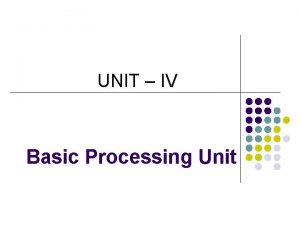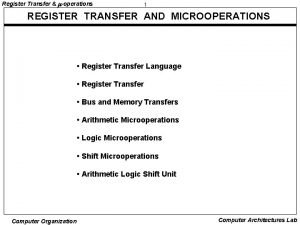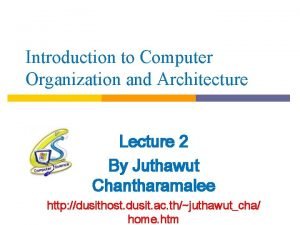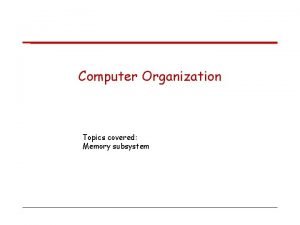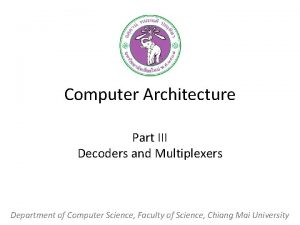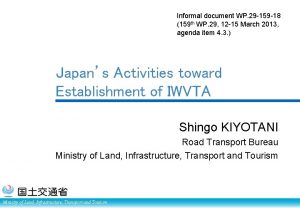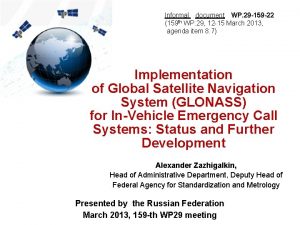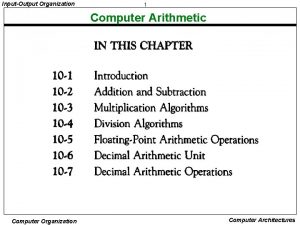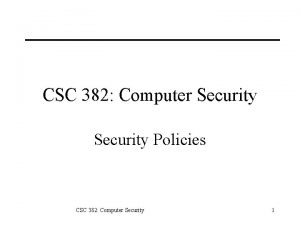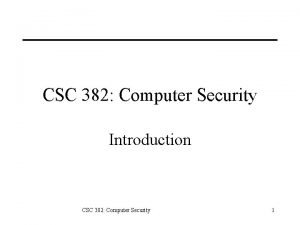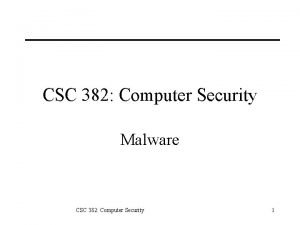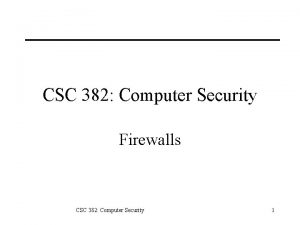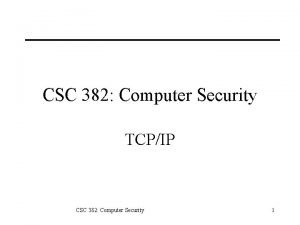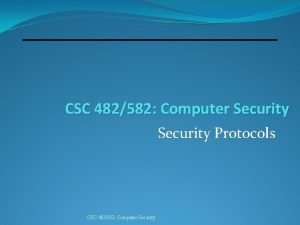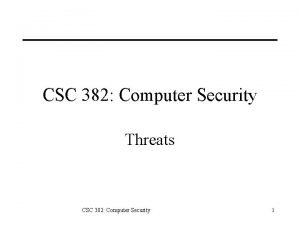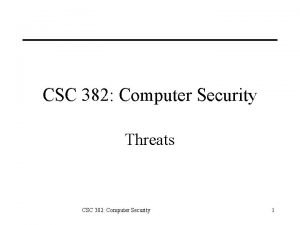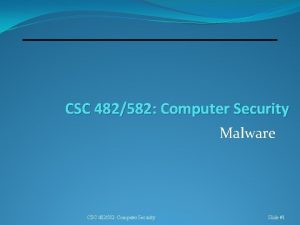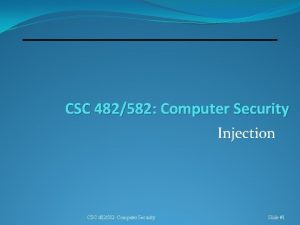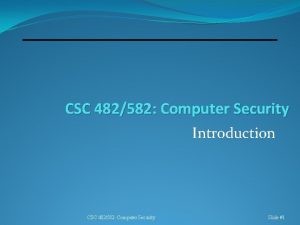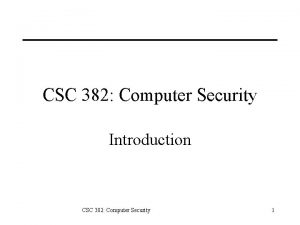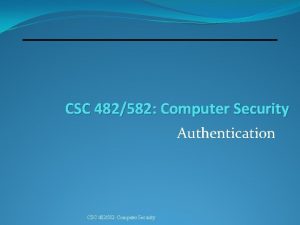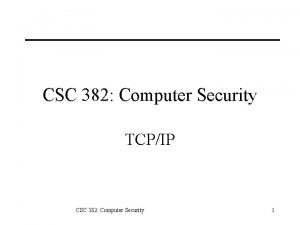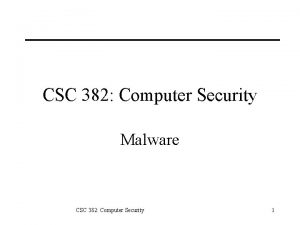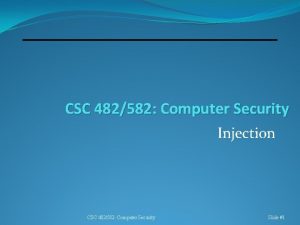CSC 159 COMPUTER ORGANIZATION CHAPTER 1 EVOLUTION OF












































- Slides: 44

CSC 159: COMPUTER ORGANIZATION CHAPTER 1 EVOLUTION OF COMPUTER ARCHITECTURE Noor Hasnita Abdul Talib

THE 0 TH GENERATION (GEN. 0) : MECHANICAL COMPUTERS m Mechanical calculating machine Inventor : Blaise Pascal (French mathematician, physicist, philosopher) First person to build a working calculating machine. The programming language Pascal is named after him. The device was built in 1642. Could only do addition and subtraction. It is entirely mechanical, using gears and powered by a hand-operated crank. • Initially used to help Pascal’s father with Tax computations! • •

THE 0 TH GENERATION (GEN. 0) CONT. . m Stepped Reckoner Inventor : Gottfried von Leibniz (German mathematician, philosopher) Took Pascal’s invention a step further. 1 n 1671, he introduced Stepped Reckoner, a mechanical calculating machine that not only can add and subtract, but also multiply, divide and evaluate square roots by series of stepped additions. • He strongly advocated the use of binary numbering system, which is fundamental in modern computers’ operation. • •

THE 0 TH GENERATION (GEN. 0) CONT. . m Loom • Inventor : Joseph Marie Jacquard • Developed in 1801, it used punched cards to control the pattern woven into cloth. The program provided by the punched cards controlled rods that raised and lowered different threads in the correct sequence to print a particular pattern. • In the years to come, variations on Jacquard’s punched cards would find variety of uses, including the storing of programs for computers.

THE 0 TH GENERATION (GEN. 0) CONT. . m Difference Engine • Inventor : Charles Babbage • (English mathematician, philosopher), sometimes called the “father of computing” • Mechanical device - could only subtract and add, designed to compute tables of numbers useful for naval navigation. • Was to run on single algorithm, the method of finite differences using polynomials. • Built in 1822.

THE 0 TH GENERATION (GEN. 0) CONT. . m Analytical Engine • Inventor : Charles Babbage in 1834. • FOUR components: the store (memory), the mill (computation unit), • • the input section (punched card reader) and the output section (punched and printed output). Intended to employ several features subsequently used in modern computers, including sequential control, branching and looping. General purpose, able to carry out different instructions/ computations. Ada Augusta Byron, the Countess of Lovelace worked closely with Babbage and developed many of the fundamental ideas in programming and program design, including the concepts of branches and loops. Ada was thus the world’s 1 st computer programmer. A modern programming language Ada® is named in her honor.

THE 0 TH GENERATION (GEN. 0) CONT. . Analytical Engine m

THE 1 ST GENERATION (GEN. 1) : VACUUM TUBES • • Use vacuum tubes for circuitry & magnetic drums for memory Vacuum tubes • • • Size is bulky/very large Made from glass • Fragile • Short-lived(heat-> burned out) Use a great deal of electricity->expensive Computers relied on machine language & could only solve one problem at a time. Input: punched cards and paper tape Output: displayed on printouts

THE 1 ST GENERATION (GEN. 1) : VACUUM TUBES CONT. . m ABC - Atanasoff and Berry Computer • Inventor : John V. Atanasoff and Clifford Berry. • Devised in 1937 to solve physics equations that • • Atanasoff was working on that time. It was the first binary-based machine. Has an arithmetic/logic unit with thirty units that can do addition/subtraction, a rotating drum memory that held thirty binary numbers of fifty digits each, and punched card input. Each punched card held five fifteen-digit decimal numbers. These numbers were converted to binary as they entered the machine. Although it has limitations, ABC was an important path mark that led to later significant advances in computer design.

THE 1 ST GENERATION (GEN. 1) : VACUUM TUBES (1945 – 1955) m The ENIAC (Electronic Numerical Integrator and Computer) • Inventor : John W. Mauchly and J. Presper Eckert at The • • University of Pennsylvania. Designed and built between 1943 and 1946. It contained 18, 000 vacuum tubes and 1500 relays. Had 20 registers, each capable of holding a 10 -digit decimal number. The system could also provide printed output. Programs could not be stored internally but were hard wired with external “patch panels” and toggle switches. ENIAC is generally considered as the first all-electronic digital computer. ENIAC led directly to the development of UNIVAC I, the world’s first commercially available computer in 1951.

Generation 1: ENIAC

UNIVAC - 1951

THE 1 ST GENERATION (GEN. 1) CONT. . • The consultant in the ENIAC project, John Von Neumann, came up with the idea of stored program. �Memory hold both program and data �Memory is address linearly �Memory is address by the location number without regard to the contained within • Program could be represented in digital form in the computer’s memory, along with the data. • His basic design is known as the Von Neumann Machine. It had 5 basic parts: the memory, the ALU, the program CU, and the input and output equipment.

THE 1 ST GENERATION (GEN. 1) CONT. . • EDVAV, IAS and UNIVAC 1(first commercially available computer)

THE 1 ST GENERATION (GEN. 1) CONT. . m The EDVAC (Electronic Discrete Variable Automatic Computer) • Developed by Mauchly and Eckert based on Von Neumann Machine. • Developed at the University of Pennsylvania. • EDVAC was completed in 1950. It stored its instructions electronically, using the binary system for instruction coding and input. The EDVAC was one of the first two-stored program computers.

THE 1 ST GENERATION (GEN. 1) CONT. . m The IAS machine. • Developed by John Von Neumann in 1947 at the Institute of Advanced • • • Studies in Princeton. Completed in 1951 and fully operational in 1952 The machine was a binary computer with a 40 -bit word, storing two 20 -bit instructions in each word. The memory was 1024 words. Negative numbers were represented in "two's complement" format. Two registers: the Accumulator (AC) and Multiplier/Quotient (MQ). Importantly, the IAS machine was the first design to mix programs and data in a single memory. It used about 2300 tubes in its circuitry. The addition time was 62 microseconds and the multiplication time was 713 microseconds. It was an asynchronous machine, meaning that there was no central clock regulating the timing of the instructions. One instruction started executing when the previous one finished.

THE 1 ST GENERATION (GEN. 1) - IAS CONT. .

THE 1 ST GENERATION (GEN. 1) CONT. . m The EDSAC (Electronic Delay Storage Automatic Calculator). • The machine, having been inspired by John von Neumann's seminal EDVAC report, was constructed by Maurice Wilkes and his team at the University of Cambridge Mathematical Laboratory in England. • EDSAC was the world's first practical stored program electronic computer, although not the first stored program computer.

THE 2 ND GENERATION : TRANSISTORS �The device that characterized the second generation computers was the transistors. �Transistor was invented in Bell Labs in 1948 by John Bardeen, Walter Brattain and William Shockley. �Transistors were made of specially treated silicon which controlled the flow of electric current.

THE 2 ND GENERATION (GEN. 2) CONT. . �Allows computers to become physically smaller, more powerful, more reliable and even faster than before. �Transistors were less expensive and smaller, required less electricity and emitted less heat than the vacuum tubes. �Fewer transistors than tubes were required to operate a computer. �Transistors were not fragile as vacuum tubes, and they lasted longer. �Use assembly language-allow programmers to specify instructions in words.

THE 2 ND GENERATION (GEN. 2) CONT. . � Generation 2 computers were still bulky and expensive, and so there were only in universities, government agencies, and large businesses � It was the beginning of big computer vendors � IBM �IBM 7094: for scientific application (1962) �IBM 1401: for business applications (1959) � DEC, Univac � CDC 6600: first “supercomputer”

THE 2 ND GENERATION (GEN. 2) CONT. . m IBM 7090 – The performance was double that of PDP-1. It was the fastest computer in the world at that time. Cost millions of dollars. Later IBM introduced the 7094. Both 7090 and 7094 marked the end of ENIAC type machines m The Burroughs B 5000 – Programmed in Algol 60, a forerunner of Pascal – The idea that software also counted was born

THE 2 ND GENERATION (GEN. 2) CONT. . m The TX-0 �The first transistorized computer built at M. I. T. this machine was merely intended as a device to test the much fancier TX-2 m PDP-1 �Manufactured by DEC in 1961. It had 4 K of 18 -bit words and a cycle time of 5 microsec. It cost $120, 000. DEC managed to sell dozens of PDP-1 s and the minicomputer industry was born �One of the PDP-1’s many innovations was a visual display (CRT) and the ability to plot points anywhere on its 512 x 512 screen. Students of M. I. T also programmed the PDP-1 to play spacewar, and the world had its first video game �A few years later DEC introduced the PDP-8 which uses a single bus, the omnibus

THE 2 ND GENERATION (GEN. 2) IBM 7094

THE 2 ND GENERATION (GEN. 2) CONT. . m CDC 6600 – Introduced by CDC. A highly parallel machine. It had several functional units for and all of them could run in parallel

THE 3 RD GENERATION : INTEGRATED CIRCUITS �In the late 50 s, Kilby and Noyce independently came up with the idea of an Integrated Circuit (IC) � Signified the beginning of third generation computers. � Integrated circuits (ICs) were single, complete electronic semiconductor circuits contained on pieces of silicon, sometimes called chips. � ICs could be manufactured by machinery, which ultimately resulted in a lower cost.

THE 3 RD GENERATION : (GEN. 3) cont. . � The IC allowed dozens of transistors to exist on a single “silicon chip”, which was smaller than the previously available single transistor � This lead computers to become smaller, faster, and cheaper � Memory technology improved. � By 1969, as many as 1, 000 transistors could be built on a chip of silicon. Magnetic disks were improved and were used more for storage. Monitors and keyboards were introduced for data input and output. � IBM System/360 were the first computers to be built entirely with ICs �Other new concept for these computers: (assembly) code was

3) cont. . m The Advantages of IC �Silicone chips were reliable, compact and cheaper �Sold hardware and software separately which created the software industry. �Customer service industry flourished (reservation and credit checks)

THE 4 TH GENERATION : PERSONAL COMPUTERS AND VLSI � The significant distinction : techniques of implementation of integrated circuits by using large-scale integration (LSI) of chips with several thousand transistors. � In the mid 1970’s the development of very large scale integration (VLSI) produced a chip containing a microprocessor. � The development of VLSI made the development of the microcomputer possible.

THE 4 TH GENERATION : PERSONAL COMPUTERS AND VLSI �Computers become even smaller & more powerful. �GUIs, mouse, handheld devices �Open architecture �The hardware design was made available to anyone. �Anyone could write software or build hardware.

personal computers

THE 4 th GENERATION (GEN. 2) CONT. . � 1989 : �Intel 486 was developed with 1 million transistors � 2000 : �released of Pentium 4 which had 42 million transistors

The 5 TH Generation 1. Artificial Intelligence. �Goal: to develop devices that respond to natural language input & are capable of learning & self organize m �Robotics �Nano-technology �Anything smaller than microtechnology

The 5 TH Generation 2. Age of connectivity �Release of WWW standards in 1990 m �Possible to connect computers all over the world �Shift towards technology that focuses on mobility (wireless revolution)

Generation 5 (present-beyond) � Applications: � Voice recognition � Natural Language Processing - programming computers to understand natural human languages � Expert System - programming Expert System - computers to make decisions in reallife situations � Games Playing – Chess and Checkers � Neural Networks - Systems that simulate intelligence � Robotics - programming computers to see and hear and react to other sensory device.

The Evolution: a summary

Stored Program Concept m John Von Neumann � A genius who spoke many languages, was an expert in the physical sciences & mathematics, had a total recall off everything he ever heard, saw or read � A consultant on the ENIAC project � Proposed significant improvements over the ENIAC design � EDVAC and IAS � Computers that store both instructions and data on the same memory are said to be based on the Von Neumann architecture.

Stored Program Concept (The Von Neumann Architecture) Forms the basis for nearly all digital computers, even now m THE PRINCIPLES : m 1. Data and instructions are both stored in the main memory while being processed 2. Sequential processing of instructions 3. Binary data processing 4. Consists of CPU, memory & I/O system

Stored Program Concept (The Von Neumann Architecture) �The basic architecture of the computer consists of:

The Von Neumann Architecture � A more complete view of the computer system architecture that integrates interaction (human or otherwise) consists of:

The Von Neumann Components �A central processing unit (CPU); it contains the control unit (CU), arithmetic/logic unit (ALU) and Interface unit �ALU: arithmetic/logic unit �Performs arithmetic and Boolean logical calculations �CU: control unit �Controls processing of instructions �Controls movement of data within the CPU �Interface unit �Moves instructions and data between the CPU and other hardware components �Bus: bundle of wires that carry signals and power between different components

The Von Neumann Components � Memory : Short-term storage for CPU calculations, Holds both instructions and data of a computer program �Input devices: keyboard, mouse, scanner, punch cards �Output devices: monitor, printer, fax machine �Storage: hard drive, optical media, diskettes, magnetic tape � Bus: bundle of wires that carry signals and power between different components

The Von Neumann Architecture In the von Neumann architecture, a small set of circuits can be driven to perform very different tasks, depending on the software program, which is executed. � The primary function of a CPU is to execute the instructions fetch from the main memory. � An instruction tells the CPU to perform one of its basic operations. � The CU is the one which interprets the instruction to be executed and which ‘tells’ the different other components of what to do. � The CPU includes a set of registers, which are temporary storage devices typically used to hold intensively used data and intermediate result.

Summary 0 5 Artificial Intelligenc e 4 Microprocessor s Mechanical GENERATION 0 -5 3 Integrated Circuits 1 Vacuum Tubes 2 Transisto rs
 Process organization in computer organization
Process organization in computer organization Basic structure of computer system
Basic structure of computer system Computer architecture and computer organization difference
Computer architecture and computer organization difference Basic computer design
Basic computer design Simple computer design
Simple computer design Father of italian sonnet
Father of italian sonnet Ai 159
Ai 159 Iso/tc 159
Iso/tc 159 Page 159
Page 159 159 ap
159 ap Cs 159
Cs 159 Surah ali imran 159
Surah ali imran 159 Mokena school district calendar
Mokena school district calendar Physisch
Physisch Modul 159
Modul 159 P 159
P 159 Iso tc 159
Iso tc 159 Fas 107
Fas 107 Route 159
Route 159 Point by point organization example
Point by point organization example Evolution and interpretation of computer architecture
Evolution and interpretation of computer architecture Computer evolution and performance
Computer evolution and performance Evolution of computer network
Evolution of computer network Computer organization and architecture 10th solution
Computer organization and architecture 10th solution Coa virtual lab iit kharagpur
Coa virtual lab iit kharagpur Introduction to computer organization and architecture
Introduction to computer organization and architecture Nano programming in coa
Nano programming in coa Bus architecture in computer organization
Bus architecture in computer organization Accessing io devices in computer organization
Accessing io devices in computer organization Data representation in computer architecture
Data representation in computer architecture Organization of digital computer
Organization of digital computer Single bus structure in computer organization
Single bus structure in computer organization Computer organization topics
Computer organization topics Single bus structure in computer organization
Single bus structure in computer organization Multiple bus structure
Multiple bus structure Computer organization & architecture: themes and variations
Computer organization & architecture: themes and variations Organization of basic computer
Organization of basic computer Performance in computer organization
Performance in computer organization Computer organization and architecture 10th edition
Computer organization and architecture 10th edition Wide branch addressing in computer organization
Wide branch addressing in computer organization Register transfer language in computer organization
Register transfer language in computer organization Organisasi sistem komputer
Organisasi sistem komputer Introduction to computer organization
Introduction to computer organization Semiconductor ram memories in computer organization
Semiconductor ram memories in computer organization Ic in computer architecture
Ic in computer architecture






